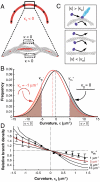Actin filament curvature biases branching direction
- PMID: 22308368
- PMCID: PMC3286980
- DOI: 10.1073/pnas.1114292109
Actin filament curvature biases branching direction
Abstract
Mechanical cues affect many important biological processes in metazoan cells, such as migration, proliferation, and differentiation. Such cues are thought to be detected by specialized mechanosensing molecules linked to the cytoskeleton, an intracellular network of protein filaments that provide mechanical rigidity to the cell and drive cellular shape change. The most abundant such filament, actin, forms branched networks nucleated by the actin-related protein (Arp) 2/3 complex that support or induce membrane protrusions and display adaptive behavior in response to compressive forces. Here we show that filamentous actin serves in a mechanosensitive capacity itself, by biasing the location of actin branch nucleation in response to filament bending. Using an in vitro assay to measure branching from curved sections of immobilized actin filaments, we observed preferential branch formation by the Arp2/3 complex on the convex face of the curved filament. To explain this behavior, we propose a fluctuation gating model in which filament binding or branch nucleation by Arp2/3 occur only when a sufficiently large, transient, local curvature fluctuation causes a favorable conformational change in the filament, and we show with Monte Carlo simulations that this model can quantitatively account for our experimental data. We also show how the branching bias can reinforce actin networks in response to compressive forces. These results demonstrate how filament curvature can alter the interaction of cytoskeletal filaments with regulatory proteins, suggesting that direct mechanotransduction by actin may serve as a general mechanism for organizing the cytoskeleton in response to force.
Conflict of interest statement
The authors declare no conflict of interest.
Figures





Comment in
-
Actin bends over backward for directional branching.Proc Natl Acad Sci U S A. 2012 Feb 21;109(8):2693-4. doi: 10.1073/pnas.1121360109. Epub 2012 Feb 9. Proc Natl Acad Sci U S A. 2012. PMID: 22323602 Free PMC article. No abstract available.
Similar articles
-
Structure of Arp2/3 complex at a branched actin filament junction resolved by single-particle cryo-electron microscopy.Proc Natl Acad Sci U S A. 2022 May 31;119(22):e2202723119. doi: 10.1073/pnas.2202723119. Epub 2022 May 27. Proc Natl Acad Sci U S A. 2022. PMID: 35622886 Free PMC article.
-
The structural basis of actin filament branching by the Arp2/3 complex.J Cell Biol. 2008 Mar 10;180(5):887-95. doi: 10.1083/jcb.200709092. Epub 2008 Mar 3. J Cell Biol. 2008. PMID: 18316411 Free PMC article.
-
Molecular dynamics simulations support a multistep pathway for activation of branched actin filament nucleation by Arp2/3 complex.J Biol Chem. 2023 Sep;299(9):105169. doi: 10.1016/j.jbc.2023.105169. Epub 2023 Aug 16. J Biol Chem. 2023. PMID: 37595874 Free PMC article.
-
Nucleation, stabilization, and disassembly of branched actin networks.Trends Cell Biol. 2022 May;32(5):421-432. doi: 10.1016/j.tcb.2021.10.006. Epub 2021 Nov 23. Trends Cell Biol. 2022. PMID: 34836783 Free PMC article. Review.
-
The state of the filament.EMBO Rep. 2005 Mar;6(3):220-6. doi: 10.1038/sj.embor.7400363. EMBO Rep. 2005. PMID: 15741975 Free PMC article. Review.
Cited by
-
Actin bends over backward for directional branching.Proc Natl Acad Sci U S A. 2012 Feb 21;109(8):2693-4. doi: 10.1073/pnas.1121360109. Epub 2012 Feb 9. Proc Natl Acad Sci U S A. 2012. PMID: 22323602 Free PMC article. No abstract available.
-
Leading edge maintenance in migrating cells is an emergent property of branched actin network growth.Elife. 2022 Mar 11;11:e74389. doi: 10.7554/eLife.74389. Elife. 2022. PMID: 35275060 Free PMC article.
-
Biochemical and mechanical regulation of actin dynamics.Nat Rev Mol Cell Biol. 2022 Dec;23(12):836-852. doi: 10.1038/s41580-022-00508-4. Epub 2022 Aug 2. Nat Rev Mol Cell Biol. 2022. PMID: 35918536 Review.
-
Single-filament kinetic studies provide novel insights into regulation of actin-based motility.Mol Biol Cell. 2016 Jan 1;27(1):1-6. doi: 10.1091/mbc.E15-06-0352. Mol Biol Cell. 2016. PMID: 26715420 Free PMC article.
-
Electron tomography and simulation of baculovirus actin comet tails support a tethered filament model of pathogen propulsion.PLoS Biol. 2014 Jan;12(1):e1001765. doi: 10.1371/journal.pbio.1001765. Epub 2014 Jan 14. PLoS Biol. 2014. PMID: 24453943 Free PMC article.
References
-
- Farge E. Mechanotransduction in development. Curr Top Dev Biol. 2011;95:243–265. - PubMed
-
- Vogel V, Sheetz M. Local force and geometry sensing regulate cell functions. Nat Rev Mol Cell Biol. 2006;7:265–275. - PubMed
-
- Janmey PA, McCulloch CA. Cell mechanics: Integrating cell responses to mechanical stimuli. Annu Rev Biomed Eng. 2007;9:1–34. - PubMed
Publication types
MeSH terms
Substances
LinkOut - more resources
Full Text Sources
Other Literature Sources
Miscellaneous

